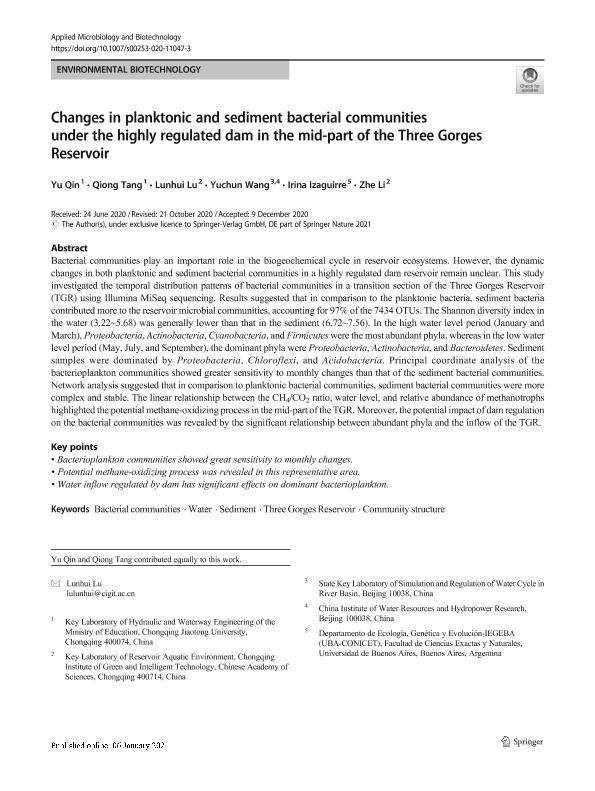Mostrar el registro sencillo del ítem
dc.contributor.author
Qin, Yu
dc.contributor.author
Tang, Qiong
dc.contributor.author
Lu, Lunhui
dc.contributor.author
Wang, Yuchun
dc.contributor.author
Izaguirre, Irina

dc.contributor.author
Li, Zhe
dc.date.available
2022-12-16T13:39:52Z
dc.date.issued
2021-01
dc.identifier.citation
Qin, Yu; Tang, Qiong; Lu, Lunhui; Wang, Yuchun; Izaguirre, Irina; et al.; Changes in planktonic and sediment bacterial communities under the highly regulated dam in the mid-part of the Three Gorges Reservoir; Springer; Applied Microbiology and Biotechnology; 105; 2; 1-2021; 839-852
dc.identifier.issn
0175-7598
dc.identifier.uri
http://hdl.handle.net/11336/181498
dc.description.abstract
Bacterial communities play an important role in the biogeochemical cycle in reservoir ecosystems. However, the dynamic changes in both planktonic and sediment bacterial communities in a highly regulated dam reservoir remain unclear. This study investigated the temporal distribution patterns of bacterial communities in a transition section of the Three Gorges Reservoir (TGR) using Illumina MiSeq sequencing. Results suggested that in comparison to the planktonic bacteria, sediment bacteria contributed more to the reservoir microbial communities, accounting for 97% of the 7434 OTUs. The Shannon diversity index in the water (3.22~5.68) was generally lower than that in the sediment (6.72~7.56). In the high water level period (January and March), Proteobacteria, Actinobacteria, Cyanobacteria, and Firmicutes were the most abundant phyla, whereas in the low water level period (May, July, and September), the dominant phyla were Proteobacteria, Actinobacteria, and Bacteroidetes. Sediment samples were dominated by Proteobacteria, Chloroflexi, and Acidobacteria. Principal coordinate analysis of the bacterioplankton communities showed greater sensitivity to monthly changes than that of the sediment bacterial communities. Network analysis suggested that in comparison to planktonic bacterial communities, sediment bacterial communities were more complex and stable. The linear relationship between the CH4/CO2 ratio, water level, and relative abundance of methanotrophs highlighted the potential methane-oxidizing process in the mid-part of the TGR. Moreover, the potential impact of dam regulation on the bacterial communities was revealed by the significant relationship between abundant phyla and the inflow of the TGR.
dc.format
application/pdf
dc.language.iso
eng
dc.publisher
Springer

dc.rights
info:eu-repo/semantics/openAccess
dc.rights.uri
https://creativecommons.org/licenses/by-nc-sa/2.5/ar/
dc.subject
BACTERIAL COMMUNITIES
dc.subject
COMMUNITY STRUCTURE
dc.subject
SEDIMENT
dc.subject
THREE GORGES RESERVOIR
dc.subject
WATER
dc.subject.classification
Biología Marina, Limnología

dc.subject.classification
Ciencias Biológicas

dc.subject.classification
CIENCIAS NATURALES Y EXACTAS

dc.title
Changes in planktonic and sediment bacterial communities under the highly regulated dam in the mid-part of the Three Gorges Reservoir
dc.type
info:eu-repo/semantics/article
dc.type
info:ar-repo/semantics/artículo
dc.type
info:eu-repo/semantics/publishedVersion
dc.date.updated
2022-09-28T16:30:40Z
dc.journal.volume
105
dc.journal.number
2
dc.journal.pagination
839-852
dc.journal.pais
Alemania

dc.journal.ciudad
Berlin
dc.description.fil
Fil: Qin, Yu. Chongqing Jiaotong University; China
dc.description.fil
Fil: Tang, Qiong. Chongqing Jiaotong University; China
dc.description.fil
Fil: Lu, Lunhui. Chinese Academy of Sciences; República de China
dc.description.fil
Fil: Wang, Yuchun. State Key Laboratory of Simulation and Regulation of Water Cycle in
River Basin; China
dc.description.fil
Fil: Izaguirre, Irina. Consejo Nacional de Investigaciones Científicas y Técnicas. Oficina de Coordinación Administrativa Ciudad Universitaria. Instituto de Ecología, Genética y Evolución de Buenos Aires. Universidad de Buenos Aires. Facultad de Ciencias Exactas y Naturales. Instituto de Ecología, Genética y Evolución de Buenos Aires; Argentina
dc.description.fil
Fil: Li, Zhe. Chinese Academy of Sciences; República de China
dc.journal.title
Applied Microbiology and Biotechnology

dc.relation.alternativeid
info:eu-repo/semantics/altIdentifier/url/https://link.springer.com/article/10.1007/s00253-020-11047-3
dc.relation.alternativeid
info:eu-repo/semantics/altIdentifier/doi/http://dx.doi.org/10.1007/s00253-020-11047-3
Archivos asociados
